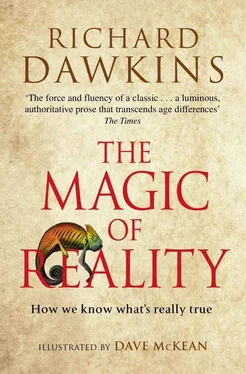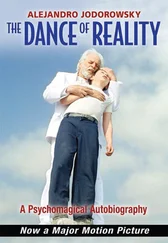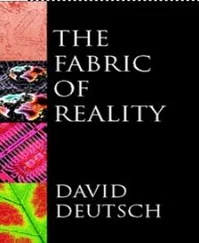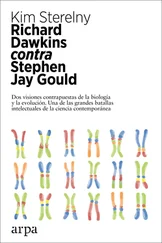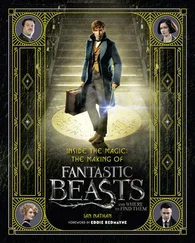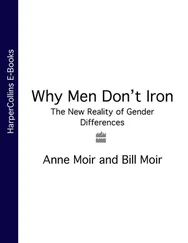For ever? Well, no, it’s not as simple as that. This is going to need a bit of explaining, and I’ll begin with a thought experiment. A thought experiment is an experiment in your imagination. What we are going to imagine is not literally possible because it takes us way, way back in time, long before we were born. But imagining it teaches us something important.
So, here is our thought experiment. All you have to do is imagine yourself following these instructions.
Find a picture of yourself. Now take a picture of your father and place it on top. Then find a picture of his father, your grandfather. Then place on top of that a picture of your grandfather’s father, your great-grandfather. You may not have ever met any of your great-grandfathers. I never met any of mine, but I know that one was a country schoolmaster, one a country doctor, one a forester in British India, and one a lawyer, greedy for cream, who died rock-climbing in old age. Still, even if you don’t know what your father’s father’s father looked like, you can imagine him as a sort of shadowy figure, perhaps a fading brown photograph in a leather frame. Now do the same thing with his father, your great-great-grandfather. And just carry on piling the pictures on top of each other, going back through more and more and more great-great-greats. You can go on doing this even before photography was invented: this is a thought experiment, after all.
How many greats do we need for our thought experiment? Oh, a mere 185 million or so will do nicely!
Mere?
MERE?
It isn’t easy to imagine a pile of 185 million pictures. How high would it be? Well, if each picture was printed as a normal picture postcard, 185 million pictures would form a tower about 220,000 feet high: that’s more than 180 New York skyscrapers standing on top of each other. Too tall to climb, even if it didn’t fall over (which it would). So let’s tip it safely on its side, and pack the pictures along the length of a single bookshelf.
How long is the bookshelf?
About forty miles.
The near end of the bookshelf has the picture of you. The far end has a picture of your 185-million-greats-grandfather. What did he look like? An old man with wispy hair and white sidewhiskers? A caveman in a leopard skin? Forget any such thought. We don’t know exactly what he looked like, but fossils give us a pretty good idea. Believe it or not, your 185-million-greats-grandfather was – a fish. So was your 185-million-greats-grandmother, which is just as well or they couldn’t have mated with each other and you wouldn’t be here.
Let’s now walk along our forty-mile bookshelf, pulling pictures off it one by one to have a look at them. Every picture shows a creature belonging to the same species as the picture on either side of it. Every one looks just like its neighbours in the line – or at least as much alike as any man looks like his father and his son. Yet if you walk steadily from one end of the bookshelf to the other, you’ll see a human at one end and a fish at the other. And lots of other interesting great- … great-grandparents in between, which, as we shall soon see, include some animals that look like apes, others that look like monkeys, others that look like shrews, and so on. Each one is like its neighbours in the line, yet if you pick any two pictures far apart in the line they are very different – and if you follow the line from humans back far enough you come to a fish. How can this be?
Actually, it isn’t all that difficult to understand. We are quite used to gradual changes that, step by tiny step, one after the other, make up a big change. You were once a baby. Now you are not. When you are a lot older you’ll look quite different again. Yet every day of your life, when you wake up, you are the same person as when you went to bed the previous night. A baby changes into a toddler, then into a child, then into an adolescent; then a young adult, then a middle-aged adult, then an old person. And the change happens so gradually that there never is a day when you can say, ‘This person has suddenly stopped being a baby and become a toddler.’ And later on there never comes a day when you can say, ‘This person has stopped being a child and become an adolescent.’ There’s never a day when you can say, ‘Yesterday this man was middle-aged: today he is old.’
That helps us to understand our thought experiment, which takes us back through 185 million generations of parents and grandparents and great-grandparents until we come face to face with a fish. And, turning round to go forwards in time, it’s what happened when your fish ancestor had a fishy child, who had a fishy child, who had a child… who, 185 million (gradually less fishy) generations later, turned out to be you.
So it was all very gradual – so gradual that you wouldn’t notice any change as you walked back a thousand years; or even ten thousand years, which would bring you to somewhere around your 400-greats-grandfather. Or rather, you would notice lots of little changes all the way along, because nobody looks exactly like their father. But you wouldn’t notice any general trend . Ten thousand years back from modern humans is not long enough to show a trend. The portrait of your ancestor of ten thousand years ago would be no different from modern people, if we set aside superficial differences in dress and hair and whisker style. He would be no more different from us than modern people are different from other modern people.
How about a hundred thousand years, where we might find your 4,000-greats-grandfather? Well, now, maybe there would be a just noticeable change. Perhaps a slight thickening of the skull, especially under the eyebrows. But it would still only be slight. Now let’s push a bit further back in time. If you walked the first million years along the shelf, the picture of your 50,000-greats-grandfather would be different enough to count as a different species, the one we call Homo erectus . We today, as you know, are Homo sapiens. Homo erectus and Homo sapiens probably wouldn’t have wanted to mate with each other; or, even if they did, the baby would probably not have been able to have babies of its own – in the same way that a mule, which has a donkey father and a horse mother, is almost always unable to have offspring. (We’ll see why in the next chapter.)
Once again, though, everything is gradual. You are Homo sapiens and your 50,000-greats-grandfather was Homo erectus . But there never was a Homo erectus who suddenly gave birth to a Homo sapiens baby.
So, the question of who was the first person, and when they lived, doesn’t have a precise answer. It’s kind of fuzzy, like the answer to the question: When did you stop being a baby and become a toddler? At some point, probably less than a million years ago but more than a hundred thousand years ago, our ancestors were sufficiently different from us that a modern person wouldn’t have been able to breed with them if they had met.
Whether we should call Homo erectus a person, a human, is a different question. That’s a question about how you choose to use words – what’s called a semantic question. Some people might want to call a zebra a stripy horse, but others might like to keep the word ‘horse’ for the species that we ride. That’s another semantic question. You might prefer to keep the words ‘person’, ‘man’ and ‘woman’ for Homo sapiens . That’s up to you. Nobody, however, would want to call your fishy 185-million-greats-grandfather a man. That would just be silly, even though there is a continuous chain linking him to you, every link in the chain being a member of exactly the same species as its neighbours in the chain.
Читать дальше
